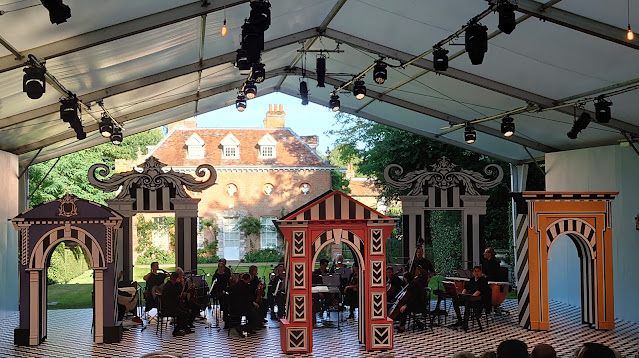Rossini: The Barber of Seville; Dominic Sedgwick, Nico Darmanin, Katie Bray, Grant Doyle, Trevor Eliot Bowes, director: Victoria Newlyn, conductor: Matthew Kofi Waldren; West Green House Opera
Reviewed 28 July 2024
Performing the piece with real engagement yet never losing sight of the importance of Rossini’s music, the cast gelled as an ensemble, with confidence and style
Spanish barbers seem to be cropping up regularly this Summer, with a new production of Rossini’s The Barber of Seville opened at Opera Holland Park last month, and Waterperry Opera will be presenting their new production next month. On 28 July 2024 we caught Rossini’s The Barber of Seville at West Green House Opera. Victoria Newlyn directed and Matthew Kofi Waldren conducted, with designs by Laura Jane Stanfield. Dominic Sedgwick was Figaro (making his role debut), with Nico Darmanin as the Count, Katie Bray as Rosina, Grant Doyle as Doctor Bartolo, Trevor Eliot Bowes as Basilio, Jeni Bern as Berta and Hector Bloggs as Fiorello.
After three years performing in the open air theatre on the lake, with its glorious setting balanced out by the need to use amplification, this year the festival returned to its original venue in a temporary structure in the garden. On Sunday evening, the setting was vindicated as the favourable weather meant that the venue’s rear wall was open, thus giving a magical view of West Green House behind the stage. This setting was leveraged in the production, so that Dominic Sedgwick’s Figaro made his entrance from the garden, and during the storm scene in Act Two the garden’s lighting responded to the musical storms happening in the orchestra.
 |
| Rossini: The Barber of Seville – West Green House Opera |
Victoria Newlyn and Matthew Kofi Waldren are old favourites at West Green, and the pair were responsible for Rossini’s La Cenerentola in 2019 [see my review] and Donizetti’s L’elisir d’amore in 2022 [see my review]. A return to the smaller theatre, with the cast in close contact with the audience, really benefitted Rossini’s comedy and a key to to the production was the sheer vividness of communication. This was about the characters on the stage rather than spectacle.
Newlyn’s imaginative production made a strong impact from the very beginning thanks to Stanfield’s striking costumes. The set, such as it was, consisted simply of a black and white checkered floor and a series of arches, which were moved constantly by the chorus. The back drop was Waldren and the orchestra with West Green House behind. Costumes were equally stylised, there were hints of period style and clear indications of Spain, but colours and patterns were vividly modern and in the second half Katie Bray’s Rosina ended up in a rather Spanish matador-like outfit featuring capri pants! There were no matching wigs, singers were presented with their own 21st-century hair. The result was an engaging and striking mix.
During the overture, Newlyn established that we were in the theatre as Sedgwick’s Figaro acted as master of ceremonies, creating the setting by directing the chorus, whilst the cast acted out the events prior to the opera. Newlyn used the chorus extensively, far more than the libretto calls for, as they moved scenery (and there was a lot of moving), and acted as auditors for some of the arias, so that Bray delivered ‘Un voce poco fa’ to the chorus and in Act Two, Jeni Bern made Berta’s aria more of an ensemble number with the chorus.
This avoidance of naturalism extended to the stylised movement of the opera. Newlyn is a choreographer too, and it was clear that this was a highly choreographed production, but only so far. There were moments of ensemble choreography, but Newlyn seems to have been aiming for keeping the cast in motion rather than relentless quasi danced numbers. This worked, and you felt the cast all developing strong and engaging personalities through music and movement.
The sense of engagement, along with surefooted pacing from both Newlyn and Waldren, meant that the opera carried well. The long first act sped by without any longeurs and without feeling rushed either.
It helped that West Green had assembled a strong and appealing cast. One of the delights of the evening was the way the singers seemed to relish the bel canto. Sometimes, performances of Rossini’s comedy are there in spite of the coloratura and I have heard plenty of performances in major houses where, for instance, the Count’s first aria was something simply to be got through. Here, every note counted and all the principals took great delighted in using Rossini’s more ornamental passages as part of the drama, so that there was a lovely knowing air in Katie Bray’s eye as she bent Rosina’s more elaborate moments to her will in ‘Un voce poco fa’.
It seems strange that Dominic Sedgwick was making his debut as Figaro, but from his first appearance he established a distinctive sense of character. This Figaro was rather full of himself with a streak of self-regard; this was no jack-the-lad, but a man conscious of his image. Sedgwick had a lovely lyrical approach to Rossini’s lines. His performance of the opening aria was winning, finely musical and rather knowing without being overdone, whilst Sedgwick made his second aria equally appealing. This Figaro was a musical creation, rather than a comic character that happened to sing. He had a nice line in patter to, and Rossini’s line seemed to flow both effortlessly and engagingly. There was often a gleam in his eye and a sense that Figaro was always moments away from twirling his moustache in satisfaction. This Figaro was a delightful and engaging creation, a world away from the traditional and all the better for it.
An experienced Rossinian, I have been enjoying Nico Darmanin’s performances in this bel canto repertoire for nearly ten years and his Count certainly did not disappoint. In the relatively intimate auditorium there was never any worry about the need to project, and throughout Darmanin was clearly enjoying and relishing the music, shaping details finely. This was all done through the filter of his delightfully dandified character. Whilst this Count projected high anxiety levels during his opening scene, worried whether Rosina would respond or not, when the plot really got going he was full of importance. The drunken soldier was not too over-done, thankfully, making the scene funny without it descending into farce, this Count had a strong sense of his own dignity (which was funny too). His musical cleric in Act Two, complete with a rather scary wig, was a true delight. All in all, you rather regretted that the traditional cut was made and the Count never got his final aria.
Katie Bray, returning to a role that she sang at Garsington Opera last year, brought her own inimitable sense of character to Rosina. There was always a gleam in her eye, a knowing look at the audience. This Rosina was outwardly demure but had a rich inner life. ‘Un voce poco fa’ was not maundering monologue, but a statement of intent sung to the male chorus. She developed a real rapport with all three of the principals, teasing her guardian, Dr Bartolo (Grant Doyle), conspiratorial with Sedgwick’s Figaro, and rather knowing with Darmanin’s Count. Their lesson scene was delightful in the way it mixed vocal virtuosity with stolen moments. But, for all the high physicality of the production, Bray never made us lose sight of the fact that Rosina was a young woman in love.
Katie Bray and Grant Doyle’s constant bickering was one of the threads running through the production. Doyle’s Bartolo was suitably domineering yet Doyle made the character’s self regard and self importance funny too. We never lost sight of the fact that in reality, Bartolo’s relationship to Rosina is effectively abusive, but Doyle drew Bartolo strongly, making his character count. And it helped that Bartolo’s implicit nastiness was undercut by his extreme self-regard and by the sight of Doyle in pink stockings, ludicrous pink shoes and a matching pink handkerchief. Doyle played Bartolo with comic relish along with a nice line in patter, keeping the character funny and engaging whilst also disturbing.
Trevor Eliot Bowes’ made Don Basilio a comic delight. Here was another self-important and rather knowing character. The combination of Bowes’ imaginative physicality and his highly expressive eyes (allied to rather camp mannerisms) meant that though the character only makes two appearances, Bowes made him linger. The calumny aria was a virtuoso combination of music and theatre, visually and musically gripping, whilst his delight in being bribed by Darmanin’s Count in Act Two was palpable.
Jeni Bern was a characterful Berta, relishing the ludicrous elements such as the constant sneezing. She made Berta’s Act Two aria something of a showpiece, flirting outrageously with the male chorus. Hector Bloggs (who also sang in the chorus) made a strong impression as Fiorello in Act One, and I certainly hope to see more of him. The nine-strong male chorus were hard working, doing both singing and movement duties as well as moving the scenery. The use of the chorus was visually imaginative and each entry seemed to have a different look, and I particularly enjoyed the rather knowing, sun glasses wearing policemen projecting a swaggering sexuality. Chorus members Dylan Rooner and Thomas Litchev gave promising performances in the roles of the office and the servant Ambrogio.
Conducting from behind the stage-action, Matthew Kofi Waldren gave a masterclass in what I think of as the traffic policeman elements of the opera. All the highly physical ensembles were admirably together, there was never a hint of communication difficulties, and Waldren’s approach was crisp and disciplined yet responsive. The music lowed admirably, yet this was bel cant which allowed the singers to shape phrases. The orchestra was playing a reduced version of the score (by Jonathan Lyness) – 12 strings and single woodwind – but the players made the music count and it never felt underpowered. Berrak Dyer (assistant conductor and repetiteur) made a discreet but supportive contribution as keyboard player in the recitatives.
This year has been somewhat difficult, financially, for West Green House Opera, requiring an element of retrenchment in the season. But none of that was apparent in this production (and I have only heard good things about this season’s Falstaff and Suor Angelica too). The performance had a confidence and style that seemed to go way beyond the idea of a production receiving just two performances at a Summer festival. The cast seemed to gel as an ensemble, performing the piece with real engagement yet never losing sight of the importance of Rossini’s music.
Never miss out on future posts by following us
The blog is free, but I’d be delighted if you were to show your appreciation by buying me a coffee.
Elsewhere on this blog
- An eclectic mix: Brixton Chamber Orchestra at Clapham Park Cube – review
- Prom 10: Ryan Wigglesworth, Laura van der Heijden & BBC Scottish Symphony Orchestra in Britten, Cheryl Frances Hoad & Elgar – concert review
- She played and sang: Gillian Dooley’s new book is the fruit of 15 years research on Jane Austen’s music collection – interview
- A world away from the Bibilical oratorio: Stanford’s Whitman setting is the focus for this disc of two of large-scale choral works – record review
- A vividly realised recording: rediscovering music by Latvian-American composer Gundaris Pone – record review
- Returning to Northern Ireland Opera for his third role, British-Ukrainian baritone Yuriy Yurchuk on Tchaikovsky’s Eugene Onegin – interview
- Relentlessly entertaining: Handel’s Acis and Galatea at Opera Holland Park rather over-eggs things but features finely engaging soloists – opera review
- Contemporary contrasts: Wolf-Ferrari’s Il segreto di Susanna & Leoncavallo’s Pagliacci in a satisfying double bill at Opera Holland Park – opera review
- A sound world that is distinctive, appealing & engaging: Maria Faust’s Mass of Mary on Estonian Record Productions – record review
- A rich sophistication of thought running through this programme that seems worlds away from the typical debut recital: Awakenings from Laurence Kilsby & Ella O’Neill – record review
- Fine singing and vivid character: a revival of John Cox’s vintage production of Mozart’s Le nozze di Figaro at Garsington – opera review
- Home










